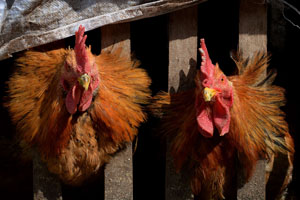China’s live poultry markets a threat to human health

Live poultry markets, common throughout China, could potentially expose many residents to novel influenza viruses, according to results of a cross-sectional study.
“Our findings highlight possible problems in the structure of the live poultry trade in China and the potential for improved protection of human and animal health,” the authors wrote in Emerging Infectious Diseases in a study funded by the NIH and the Harvard Center for Communicable Diseases Dynamics.
A total of 404 laboratory-confirmed cases of human influenza A(H7N9) virus have been reported as of March 2014, with 394 in mainland China, two in Taiwan, seven in Hong Kong and one in Malaysia. Research indicates that most human infections result from exposure to live poultry, especially in urban, live poultry markets.
To determine risk perception and behavior after a recent influenza A(H7N9) outbreak in China, the researchers surveyed 2,504 urban residents in five cities and 1,227 rural residents in four provinces. The perceived risk for contracting influenza A(H7N9) was low for both urban and rural respondents.
Among urban residents, exposure to live poultry markets is common. Between 20% and 50% of participants indicated that they had visited a live poultry market in the previous year. Guangzhou had the highest exposure rate, with 47% of respondents visiting a live poultry market at least once in the preceding year. Most participants had close contact with live poultry before it was slaughtered.
Seventy-seven percent of urban residents said they visited live markets less often after the first cases of influenza A(H7N9) were reported in China. Only 30% of respondents supported the permanent closure of these markets as a way to contain the spread of disease. Support for market closure was particularly low in cities that were unaffected by the virus.
In rural areas, 48% of participants said they raised at least one type of backyard poultry, such as chickens, ducks and geese.
“Exposures to live poultry are common in many areas of China,” the authors wrote. “If influenza A(H7N9) virus were to become more prevalent among poultry, the number of human exposures could be substantial in the absence of control measures.”













